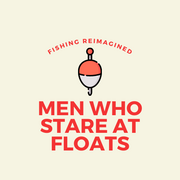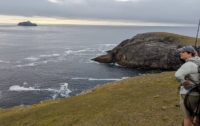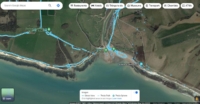TL;DR
- Lower-light, overcast conditions tend to fish best
- Calmer, high-pressure periods with offshore wind tend to fish best in the summer months
- In the winter months, a sudden change in pressure and subsequent storm/onshore wind create the perfect conditions
- Temperate waters somewhere around 15°C and fish will almost entirely shut off when it is too cold
- After sustained periods of warm weather, a temperature shift or cool rain can send fish into a frenzy
Until you begin to understand how the weather impacts your fishing environment, you will always be on the back foot. Particularly if you’re a sea fisherman. Coarse fishing environments, particularly private lakes, tend to be much more stable than the sea and are less affected by weather conditions. But you can still maximise your chances by understanding what impact the conditions have on your target species.
Top 25 Sea Fishing Tips for UK Waters
For example, most beginner fishermen would baulk at the sight of a storm. But the more experienced among us would see it as an opportunity. Whilst the summer months tend to fish best with sustained periods of calm weather, a low-pressure front and subsequent storm in the winter churns up baitfish and typically leads to a feeding frenzy in both salt and freshwater environments.
Below we’ve reviewed what the best weather conditions are for fishing in the UK, what apps give you the best information and the weather conditions to avoid when fishing. So strap in and, when you’re done, move on to understanding the tides when fishing.
Table of contents
What is the best weather for fishing in the UK?
Generally, fishing in the UK tends to be the most productive in overcast conditions around dawn or dusk when the light is present, but low and the temperature is mild. Much like Goldilocks, either too cold or too hot is perfect. Rain can be both positive and negative as it can encourage certain fish to feed, and the disruption to the water’s surface can provide extra cover for predatory species.
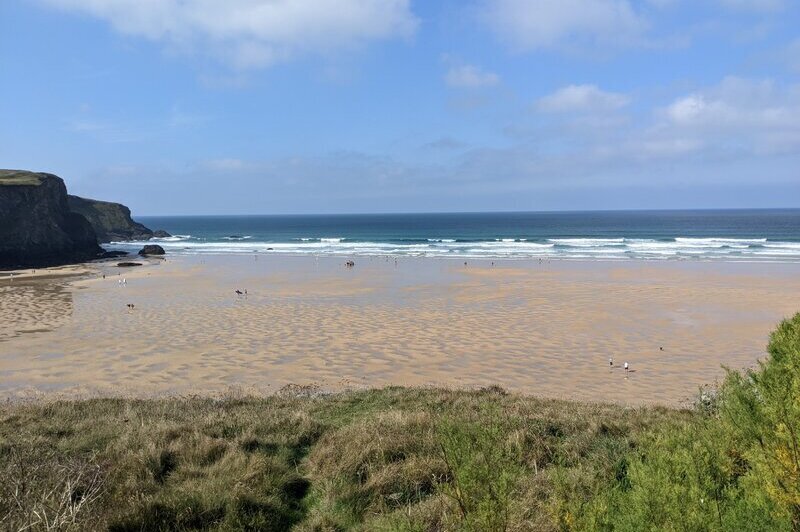
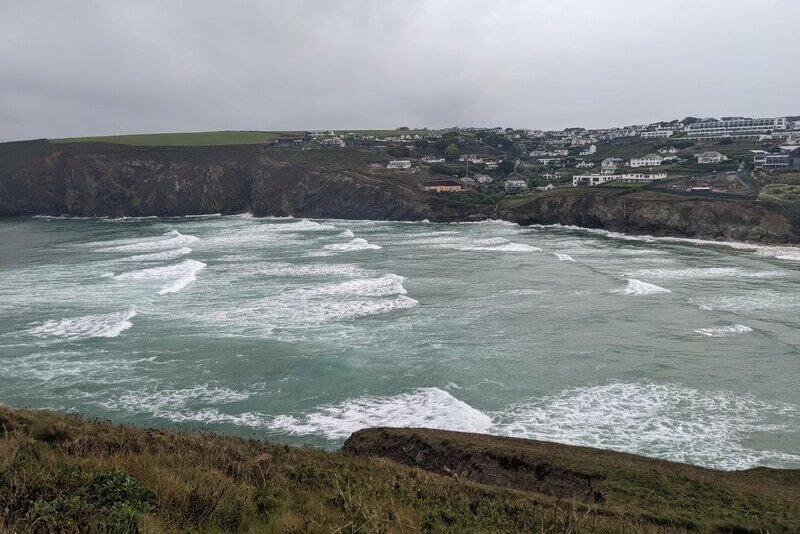
Give us overcast and stormy conditions any day for fishing
It’s important to note that every mark fishes slightly differently. This is particularly prevalent if you were to compare how the prevailing weather conditions affect a coarse fishing lake vs the sea. Coarse fishing lakes are private, almost self-contained ecosystems where fish tend to follow particular patterns when it comes to feeding. You tend to know how the fish will behave because of it.
Contrasting this to fishing in the sea, the weather conditions can play a significant role when it comes to your ability to catch a fish. High winds and tides can make the sea almost unfishable. Even something as simple as clear overhead conditions leave nowhere for predators to hide which, from personal experience, makes fish much less likely to take your lure. It is unclear whether that’s because they can see your line and feel like something’s off or they just aren’t hunting.
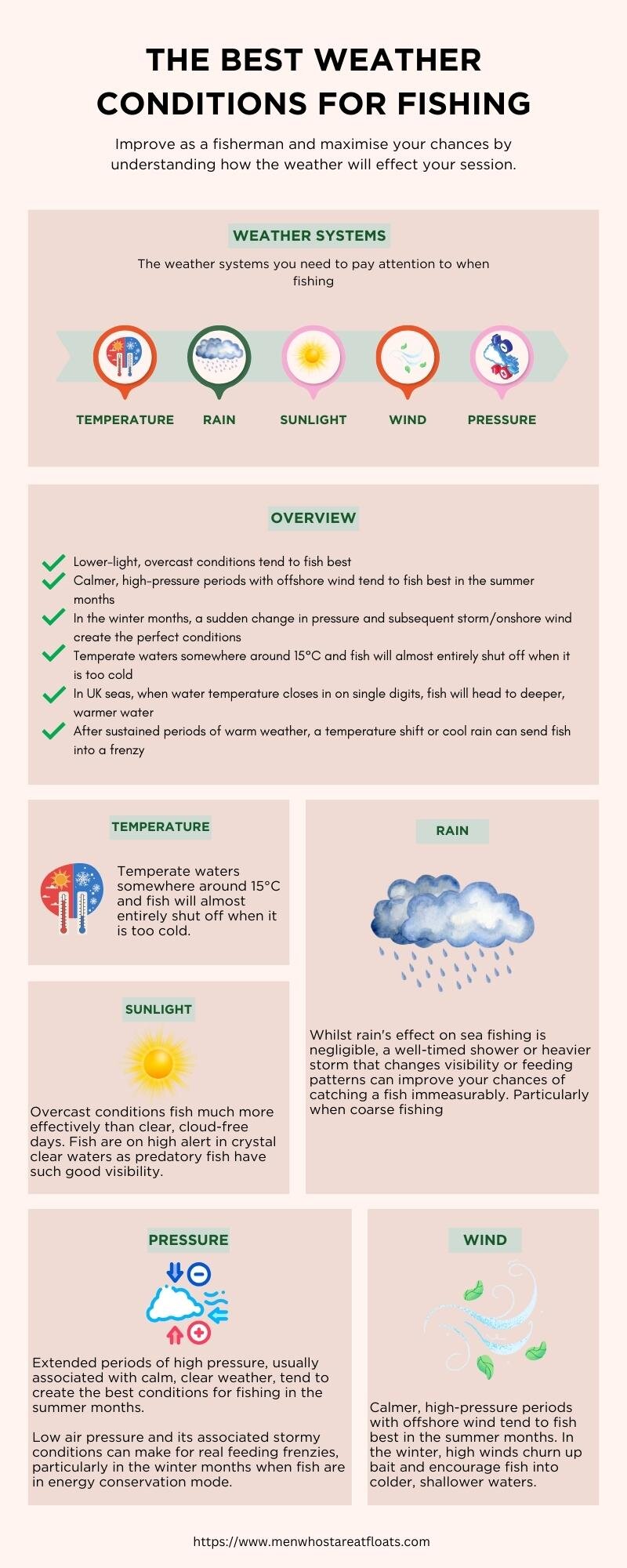
Temperature
There is no set rule for the perfect temperature for fishing, but there are some very good rules to follow. Typically cold snaps are a disaster for coarse fishing. When the water temperature drops below a certain point, fish will go into energy conservation mode and will only feed intermittently.
Water temperature is much slower to change than air temperature, but is much more consistent. The larger the body of water, the more consistent the temperature and the warmer late spring through to early autumn months mean the water temperatures tend to peak in September/October time in the UK.
Angling Time’s Guide to Understanding Water TemperatureAccording to Dr Mark Burdass (who is specifically talking about coarse fishing): “When the water temperature falls below 4ºC most of our coarse fish shut down. Some native species like pike and chub will feed intermittently but non-native species like carp are particularly affected.
“At a temperature of 4ºC the affected fish will often shoal together in the warmest spot they can find and stay there virtually dormant…”
Fish aren’t looking for food anywhere near as readily in the coldest winter months and unless you’re able to land your lure or bait right under their nose, the chance of you landing one is slim to none. This is particularly true if a cold snap has brought on the colder water temperature. Long spells of cold mean fish will have to feed a little more frequently.
In the late winter months when the water is at its coldest, fish will seek out the deepest pockets of water as this is where heat is retained the longest. In the warmer late summer months, fish will return to the surface and the shallows to feed.
Rain
Whilst rain is not necessarily the most pleasant of conditions (make sure you get yourself a good fishing waterproof) it doesn’t have much effect on the fish when sea fishing.
However, a well-timed shower or heavier storm can improve your chances of catching a fish immeasurably. For example, after a period of consistently warm summer days, a cooler rain shower creates change and – in many cases – causes fish to hunt. Conversely, in the wetter spring and winter months, another cold shower is unlikely to impact fishing conditions in any positive manner.
The Ginger Fisherman has a number of videos of him targeting predatory fish after and even during a storm. Overcast, cool conditions and consistent rain are fantastic for coarse fishing, targeting predators like pike. These conditions are perfect for targeting some massive fish and the end of a storm signals your time to pick up your gear and get out there.
Sunlight
As a general rule, overcast conditions fish much more effectively than clear, cloud-free days. Fish are on high alert in crystal clear waters as predatory fish have such good visibility. Fish that rely on their sight to hunt (bass being a prime example) may be able to see your line in the water or your terminal tackle attaching your lure to your line. So whilst predators may be out hunting in clearer conditions, bait fish and the predators themselves may be able to see too much.
Wind
The wind is a nightmare for most anglers; tangled lines, low visibility and choppy waters are all things we’d rather avoid. When fishing in the sea, the wind direction can play a key role in the behaviour of the fish. There are two types of wind to be aware of – onshore wind and offshore wind.
Onshore wind
In the colder months, Onshore wind (wind blowing towards the shore) tends to make casting much more of a challenge and whips the sea up into a frenzy. You may think this creates unpalatable conditions for fishing (which is in part true), but as the sea churns, limpets, crabs, mussels and bait fish are dislodged from the rocks, weeds and crannies creating a bit of a feeding frenzy. In these scenarios, predatory fish will move inshore to take advantage of the prevalence of food. This is why going fishing just after a storm can be so productive.
Offshore wind
Offshore wind (wind blowing out to sea) kills the waves and creates much calmer conditions, which, in the cooler months, doesn’t create good fishing conditions. This means the bait churned up by onshore winds is no longer present, which means there’s nothing to entice larger fish into shore. So if it’s big fish you’re after, an onshore wind is exactly what you need.
How to Find a Fishing Spot
Wind in the summer months
Frustratingly, wind in the summer months works conversely in the winter months. This is because the majority of target species for sea fishermen spend the colder months in warmer, deeper waters to breed and feed, following the baitfish inshore as the water warms. Stormy conditions and water discolouration discourage the fish from coming as close as they traditionally do in summer, staying out of range of the shore angler.
TL;DR: Longer periods of sustained calm weather in the summer months tend to bring the best results as the fish are already inshore and bait is prevalent. In the colder, winter months, stormy conditions or onshore wind churns the sea up and encourages fish to come in closer to the shore.
Pressure
Stripping it back to its very basics, the Earth’s atmosphere exerts pressure on its surface. This pressure is measured in hectoPascals (hPa), also called millibars. Standard pressure at sea level is defined as 1013hPa and these areas of high and low pressure are caused by ascending and descending air. As air warms it ascends (you’ll be aware of the saying hot air rises), leading to low pressure at the surface. As air cools it descends, leading to high pressure at the surface. This is because warm air is lighter than cold air.
High-pressure systems
Fishing-wise, extended periods of high pressure, usually associated with calm, clear weather, tend to create the best conditions for fishing. Particularly in the summer months when the fish are closer to shore. This period of calm helps the fish find the ideal conditions for feeding: water temperature, dissolved oxygen, light penetration for hunting etc.
Low-pressure systems
Low air pressure, usually as a result of warming, is typically associated with stormy conditions. Whilst fishing can be superb after a storm (particularly in the winter months), low-pressure systems usually signify a cold front, which can completely shut down feeding activity in rivers, lakes and smaller bodies of freshwater. If it has been a hot summer and the water temperature is particularly high, a sudden cold snap that cools the shallows slightly can snap the fish into action. So it’s not all bad.
In the summer months, long periods of calm, high-pressure systems are good for fishing. In the winter months, a sudden change in pressure and subsequent storm can create the ideal fishing conditions.
What weather apps do fishermen use?
There are dozens of fishing weather apps, but the ones we tend to use are;
- Fishing forecast: Google Play Store & Apple Store
- Fishbrain
- Windy.app
- Fishing Points
- Nautide
How do I find the sea fishing forecast?
There are numerous sites and apps you can use to find the fishing forecast including Fishbrain, Fishing Forecast et al alongside websites like;
- Met Check: a fantastic all-in-one website for checking the temperature, air pressure, wind speed, rain and sunlight
- Tides 4 Fishing: our personal favourite that determines wind speed, direction, temperature, visibility, air pressure, water temperature and swell among other things
- Net Weather: overhead conditions, temperature, wind direction and speed, air pressure, rainfall, cloud cover and a ‘bite guide’ metric which we like
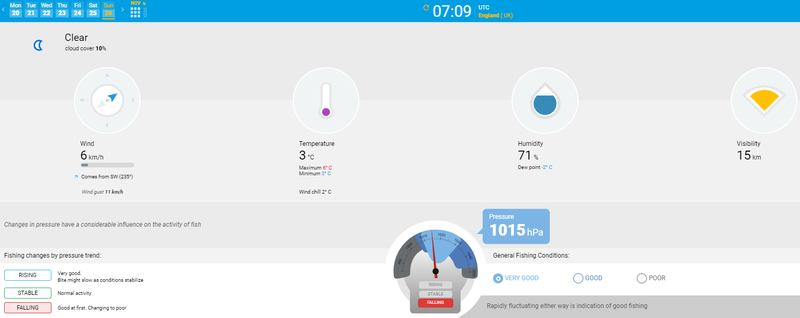
What weather conditions are bad for fishing?
Generally, bad fishing conditions are;
- Bright sunlight
- Low-pressure systems and temperatures (although sudden cold snaps during extended periods of very warm weather can work in your favour)
- High winds
- Onshore wind in the summer
- Offshore wind in the winter
FAQs
Can you fish all year round in the UK?
You can fish all year around in the UK in the sea with virtually no restrictions, just be wary in the colder winter months. However, if you’re coarse fishing there is a coarse fishing close season that runs between March 15th – June 15th that applies to all rivers and lakes, outside of some privately owned waters.
Does rain affect sea fishing?
Rain has a negligible impact on fishing in the sea. Rain can offer slightly more disturbance on the water’s surface, which can benefit both predatory fish and fishermen when hunting.
Conversely, it can provide more shelter for bait fish. If the rain comes after an extended period of calm, particularly in the summer months, it can cause a reaction. Whether that reaction is for the fish to start or stop hunting is entirely dependent on the preceding period.
What is the best air pressure for fishing?
Typically high pressure fronts create an extended period of calm weather which, in the summer months, create the perfect environment for fishing. The inverse is true in winter, when fish who have been feeding and residing in the warmer, deeper waters come in after a stormy low-pressure front to feed in the churned-up water.
As a general rule, look for changes in pressure fronts and fish the calm after a storm in winter and in calmer, high-pressure fronts in summer.
At what temperature are fish most active?
The perfect temperature for fish activity is freshwater tends to be around the 15 degree celsius mark. In the sea, the ideal temperature for most fish activity is somewhere around the 12-18 degree celsius mark.
The majority of fish are most active in temperatures that are neither too hot or too cold. When the water is too cold, fish conserve their energy and pool together in deeper, warmer pockets. When the water is too warm fish seek out the shallower, cooler pockets, but are also less likely to feed.
Do fish feed in hot weather?
Fish do feed in hot weather, but the water temperature is far more important than the air temperature. Unusually hot days in cooler months will have no impact on the water temperature and are unlikely to affect feeding patterns.
However, in extended periods of hot weather that warm the water, fish will start to move closer to the shore and/or surface and generally become more active as their core temperature warms slightly and energy conservation is less important. There is a tipping point, when water temperature becomes too hot and turns the fish off the feed entirely.
Tags: Sea FishingWeather
Hi, I'm Harry. A keen, albeit exceedingly average fisherman. I've spent the last few years trawling London's waterways with - if I'm being kind - varied success and would love to help you avoid the mistakes I have made.
